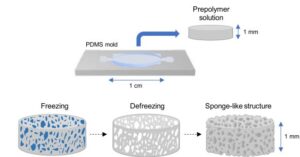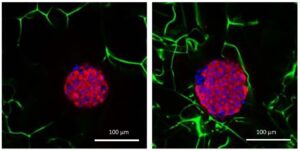BLOC co-coordinator Javier Ramón from IBEC led a work recently published in the Journal Biofabrication describing a new technology that increases the performance of pancreatic cells grown in vitro and induces their organization in β-cell clusters, similarly to the spheroid-like structures found in vivo. This new technology will be crucial to develop BLOC’s benchtop NMR to study metabolic diseases as diabetes.
Pancreatic islets are responsible for maintaining glucose homeostasis by secreting the hormones insulin and glucagon. When cells from peripheral tissues cannot properly use this insulin, an imbalanced situation occurs that may end with the development of type 2 diabetes, characterized by an excess of glucose. This chronic metabolic disorder is considered a global pandemic affecting more than 400 million people worldwide. Despite its prevalence, research in this field have been classically based on the use of monolayer cell cultures that do not accurately reproduce the in vivo physiology of pancreatic islets, limiting to reveal naturally occurring processes and reducing the consistency of in vitro experiments.

To face these constraints, researchers led by Javier Ramon developed a scaffold based on carboxymethyl cellulose (CMC) cryogels, improving its mechanical and physical properties when compared to gelatin-based scaffolds. This new scaffold allows to engineer pancreatic cells, generating β-cell clusters and creating specific range pseudoislets. In summary, they can reproduce in vitro the round-shaped cell aggregations of around 100 µm in diameter that form the pancreatic islets. Besides these advantages, the new scaffold also increases the cell viability for up to 7 days and the response to glucose over conventional monolayer cultures.

The new scaffold developed in this work is a key point to attain the main objective of BLOC project, as it will allow to satisfactorily engineer the pancreatic islets that will be used in the benchtop nuclear magnetic resonance (NMR) to study metabolic diseases as diabetes. The use of a suitable 3D tissue engineering system makes possible to precisely position the cells to simulate the native structure of the tissue under study.
Reference article: Cellulose-based scaffolds enhance pseudoislets formation and functionality. Ferran Velasco-Mallorquí; Júlia Rodríguez-Comas and Javier Ramón-Azcón. 2021. Biofabrication 13, 035044.
You can read the complete publication here:
Cellulose-based scaffolds enhance pseudoislets formation and functionality – IOPscience